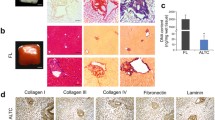Abstract
The development of new approaches for organ transplantation has become crucial in the last years. In particular, organ engineering, involving the preparation of acellular matrices that provide a natural habitat for reseeding with an appropriate population of cells, is an attractive although technically demanding approach. We here describe a method that allows for the derivation of functional in vitro hepatic organoids and that does not require a previous selection of all the parenchymal hepatocytes and non-parenchymal cells, namely, Kupffer cells, liver endothelial cells, and hepatic stellate cells. The procedure also replaces the costly standard collagenase perfusion step with a trypsin-based enzymatic digestion that results in high-yield decellularization. A combination of physical and chemical treatments through deep immersion and intraluminal infusion of two different consecutive solutions is used: (1) deionized water (DI) and (2) DI + Triton X 1% + ammonium hydroxide (NH4OH) 0.1%. This ensures the isolation of the hepatic constructs that reliably maintain original architecture and ECM components while completely removing cellular DNA and RNA. The procedure is fast, simple, and cheap and warrants an optimal organoid functionality that may find applications in both toxicological and transplantation studies.
Access this chapter
Tax calculation will be finalised at checkout
Purchases are for personal use only
Similar content being viewed by others
References
Mokdad AA, Lopez AD, Shahraz S, Lozano R, Mokdad AH, Stanaway J, Murray JLC, Naghavi M (2014) Liver cirrhosis mortality in 187 countries between 1980 and 2010: a systematic analysis. BMC Med 12:145. https://doi.org/10.1186/s12916-014-0145-y
Badylak SF, Taylor D, Uygun K (2011) Whole-organ tissue engineering: Decellularization and recellularization of three-dimensional matrix scaffolds. Annu Rev Biomed Eng 13:27–53. https://doi.org/10.1146/annurev-bioeng-071910-124743
Gilbert TW, Sellaro TL, Badylak TF (2006) Decellularization of tissues and organs. Biomaterials 27(19):3675–3683. https://doi.org/10.1016/j.biomaterials.2006.02.014
Gilbert TW (2012) Strategies for tissue and organ decellularization. J Cell Biochem 113(7):2217–2222. https://doi.org/10.1002/jcb.24130
Ott HC, Matthiesen TS, Goh SK, Black LD, Kren SM, Netoff TI, Taylor DA (2008) Perfusion-decellularized matrix: using nature's platform to engineer a bioartificial heart. Nat Med 14(2):213–221. https://doi.org/10.1038/nm1684
Tapias LF, Ott HC (2014) Decellularized scaffolds as a platform for bioengineered organs. Curr Opin Organ Transplant 19(2):145–152. https://doi.org/10.1097/MOT.0000000000000051
Uygun BE, Soto-Gutierrez A, Yagi H, Izamis ML, Guzzardi MA, Shulman C, Milwid J, Kobayashi N, Tilles A, Berthiaume F, Herti M, Nahmias Y, Yarmush ML, Uygun K (2010) Organ reengineering through development of a transplantable recellularized liver graft using decellularized liver matrix. Nat Med 16(7):814–820. https://doi.org/10.1038/nm.2170
Shupe T, Williams M, Brown A, Willenberg B, Petersen BE (2010) Method for the decellularization of intact rat liver. Organogenesis 6(2):134–136. PMCID: PMC2901817
Barakat O, Abbasi S, Rodriguez G, Rios J, Wood RP, Ozaki C et al (2012) Use of decellularized porcine liver for engineering humanized liver organ. J Surg Res 173(1):e11–e25. https://doi.org/10.1016/j.jss
Rahman TM, Hodgson HFJ (2000) Animal models of acute hepatic failure. Int J Exp Pathol 81(2):145–157. https://doi.org/10.1046/j.1365-2613.2000.00144.x
Acknowledgement
This work was supported by Carraresi Foundation and by Fondazione CMT Cura Mini-invasiva Tumori ONLUS. T.A.L.B., F.G., M.G., and A.Z. are members of the COST Actions CA16119.
Author information
Authors and Affiliations
Corresponding author
Editor information
Editors and Affiliations
Rights and permissions
Copyright information
© 2017 Springer Science+Business Media New York
About this protocol
Cite this protocol
Ghiringhelli, M. et al. (2017). Simple and Quick Method to Obtain a Decellularized, Functional Liver Bioscaffold. In: Turksen, K. (eds) Decellularized Scaffolds and Organogenesis. Methods in Molecular Biology, vol 1577. Humana Press, New York, NY. https://doi.org/10.1007/7651_2017_97
Download citation
DOI: https://doi.org/10.1007/7651_2017_97
Published:
Publisher Name: Humana Press, New York, NY
Print ISBN: 978-1-4939-7655-3
Online ISBN: 978-1-4939-7656-0
eBook Packages: Springer Protocols




